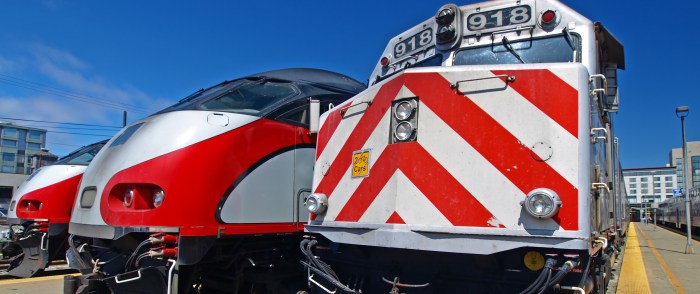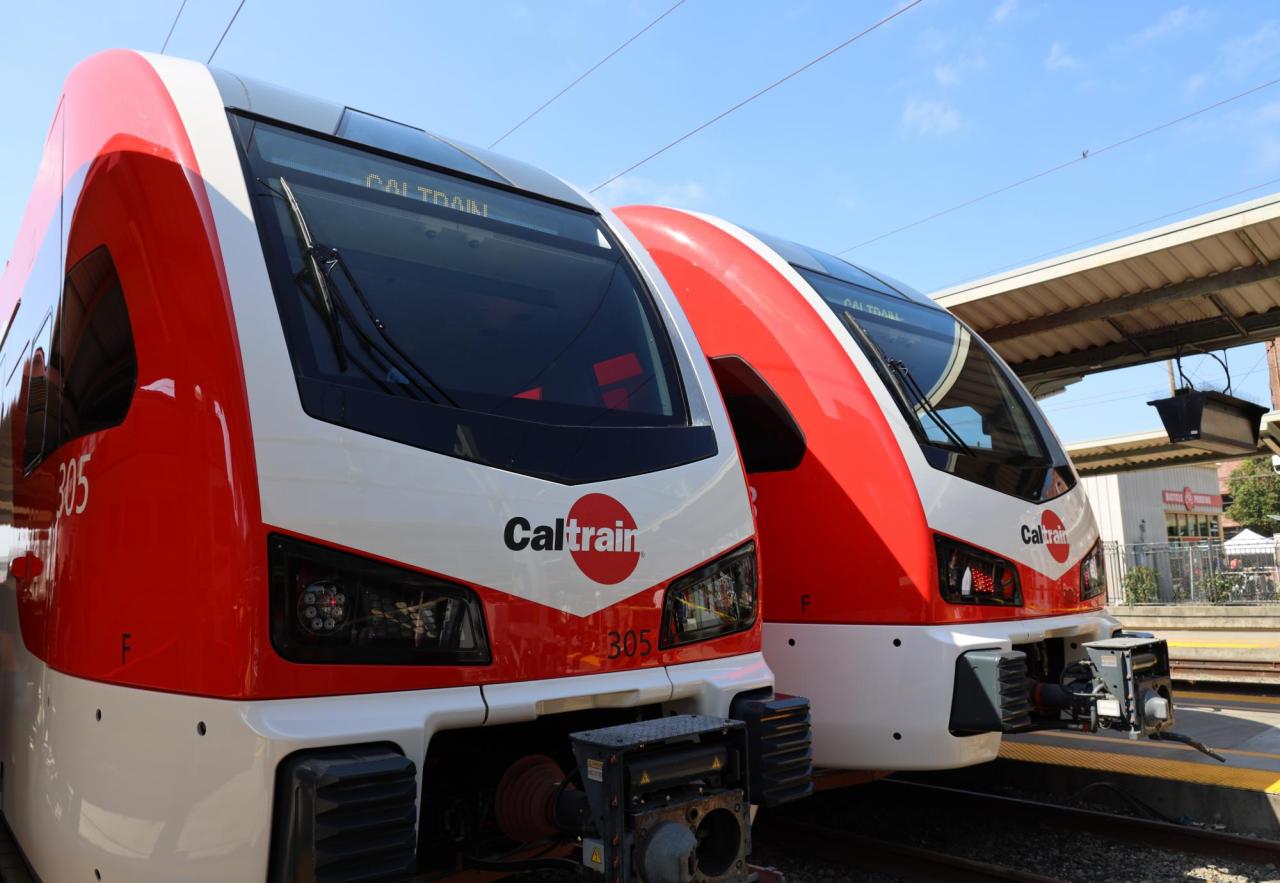Caltrain launches full schedule of electrified train service this weekend sets the stage for a new era of transportation in the Bay Area. This long-awaited milestone marks the culmination of years of planning, construction, and investment, ushering in a future where commuters can enjoy faster, more reliable, and environmentally friendly travel.
The electrification project has transformed Caltrain, enhancing the passenger experience with upgraded interiors, improved accessibility, and enhanced Wi-Fi connectivity. The new electric trains are quieter, more efficient, and emit zero emissions, contributing to a cleaner and healthier environment for everyone.
Caltrain Electrification

Caltrain’s full electrification marks a significant milestone in the region’s transportation landscape, ushering in a new era of efficient, reliable, and sustainable commutes. This long-awaited achievement culminates years of planning, construction, and collaboration, transforming the Peninsula’s transportation system.
The Electrification Journey
Caltrain’s electrification project is a testament to the region’s commitment to sustainable transportation and the vision of a modern, efficient rail system. The project’s timeline is marked by key milestones and challenges overcome:
- 2008:Caltrain’s Board of Directors approved the electrification project, recognizing the need for a cleaner and more efficient rail system.
- 2012:The Federal Transit Administration (FTA) awarded Caltrain a $647 million grant, marking a crucial step towards project funding.
- 2017:Construction began on the electrification project, involving extensive track upgrades, overhead catenary system installation, and new electric trainsets.
- 2022:The first electrified train service began operating, marking a significant step towards full electrification.
- 2024:Caltrain’s full electrification is achieved, ushering in a new era of service for the Peninsula.
Environmental Benefits
Caltrain’s electrification brings significant environmental benefits, contributing to a cleaner and healthier environment for the region.
- Reduced Emissions:Electrified trains eliminate diesel emissions, significantly reducing greenhouse gas emissions and improving air quality. Studies show that electrified trains emit significantly less greenhouse gases than diesel trains, contributing to a cleaner environment.
- Improved Air Quality:The absence of diesel emissions leads to cleaner air for communities along the Caltrain corridor, particularly in urban areas where air pollution is a major concern. This improved air quality benefits public health, reducing respiratory problems and improving overall well-being.
Technological Advancements and Infrastructure: Caltrain Launches Full Schedule Of Electrified Train Service This Weekend

Caltrain’s electrification represents a significant leap forward in sustainable transportation, requiring a substantial investment in both technology and infrastructure. This transformation involves a complex interplay of components, from the power source to the electric locomotives, and necessitates comprehensive upgrades to the existing rail system.
Examine how Emmys showdown: All 20 times costars battled each other for Best TV Movie/Limited Series Actress PHOTOS can boost performance in your area.
Power Source
The electrification of Caltrain relies on a dedicated high-voltage direct current (HVDC) power source. This power is supplied by the California Independent System Operator (CAISO) and delivered to the Caltrain system via a new substation built in San Bruno. The HVDC system is designed to provide reliable and efficient power for the electric locomotives, ensuring a consistent and robust energy supply for the entire Caltrain network.
Overhead Catenary System, Caltrain launches full schedule of electrified train service this weekend
The heart of the electrification project is the overhead catenary system, a network of wires and supports that carry electricity to the trains. This system consists of two main components: the overhead contact wire and the supporting structures. The contact wire, which is typically made of copper or aluminum, carries the electric current and is suspended above the tracks.
The supporting structures, such as poles and brackets, are strategically placed along the rail line to hold the contact wire in place. The catenary system is designed to withstand the forces of wind, rain, and other environmental factors, ensuring a reliable flow of electricity to the trains.
Electric Locomotives
Caltrain’s new electric locomotives, the Siemens Charger, are a state-of-the-art example of sustainable transportation technology. These locomotives are designed for high-speed operation and are equipped with regenerative braking, a system that captures energy during braking and feeds it back into the power grid.
The Charger locomotives are also equipped with advanced safety features, including collision avoidance systems and automatic train control, enhancing passenger safety and operational efficiency.
Infrastructure Upgrades
Electrifying the Caltrain system required extensive infrastructure upgrades and modifications. This included:
- New Substations:The construction of new substations, like the one in San Bruno, to provide the necessary power for the electrified system.
- Overhead Catenary System Installation:The installation of the overhead catenary system, which involved extensive work to erect poles, string wires, and ensure proper alignment and tension.
- Track Improvements:Upgrades to the existing track infrastructure, including track replacement, alignment adjustments, and the installation of new signaling systems.
- Station Modifications:Modifications to existing stations, including the installation of platform extensions and new platform shelters, to accommodate the new electric locomotives.
- Signal System Upgrades:Upgrades to the signaling system to accommodate the increased speed and frequency of electric trains, ensuring safe and efficient operation.
Challenges and Opportunities
Maintaining and operating the electrified train service presents both challenges and opportunities:
- Maintenance:The catenary system requires regular inspection and maintenance to ensure its integrity and reliability. This includes monitoring for wear and tear, repairing damaged components, and performing routine inspections to prevent potential issues.
- Power Supply:Ensuring a reliable and consistent power supply is critical for the smooth operation of the electrified system. This involves coordinating with the power provider, CAISO, to ensure sufficient capacity and addressing potential power outages.
- Environmental Considerations:The electrification of Caltrain has significant environmental benefits, reducing greenhouse gas emissions and improving air quality. However, it’s important to address potential environmental impacts associated with the construction and maintenance of the infrastructure, such as minimizing disruption to wildlife habitats.
- Safety:The safety of passengers and staff is paramount. This includes ensuring the proper functioning of safety systems on the trains and the infrastructure, as well as implementing robust safety protocols for maintenance and operations.
- Operational Efficiency:The electrification project presents opportunities for increased operational efficiency, including faster train speeds, reduced maintenance costs, and improved reliability. This can translate into enhanced passenger satisfaction and more frequent service.
Outcome Summary
With the full implementation of electrified service, Caltrain is poised to become a vital component of the Bay Area’s transportation network, attracting more riders and promoting sustainable commuting. The future looks bright for Caltrain, as it continues to innovate and expand its service, connecting communities and fostering a more sustainable future for the region.
FAQ Corner
When will the new electric trains be in service?
The full schedule of electrified train service begins this weekend.
What are the benefits of electrified train service?
Electrified train service offers numerous benefits, including faster and more reliable service, reduced emissions, and improved air quality.
Will there be any changes to Caltrain’s routes or schedules?
Caltrain’s routes and schedules will remain largely the same, but there may be some minor adjustments to optimize service with the new electric trains.
How can I learn more about Caltrain’s electrification project?
You can find detailed information about Caltrain’s electrification project on their website and social media channels.
 CentralPoint Latest News
CentralPoint Latest News

